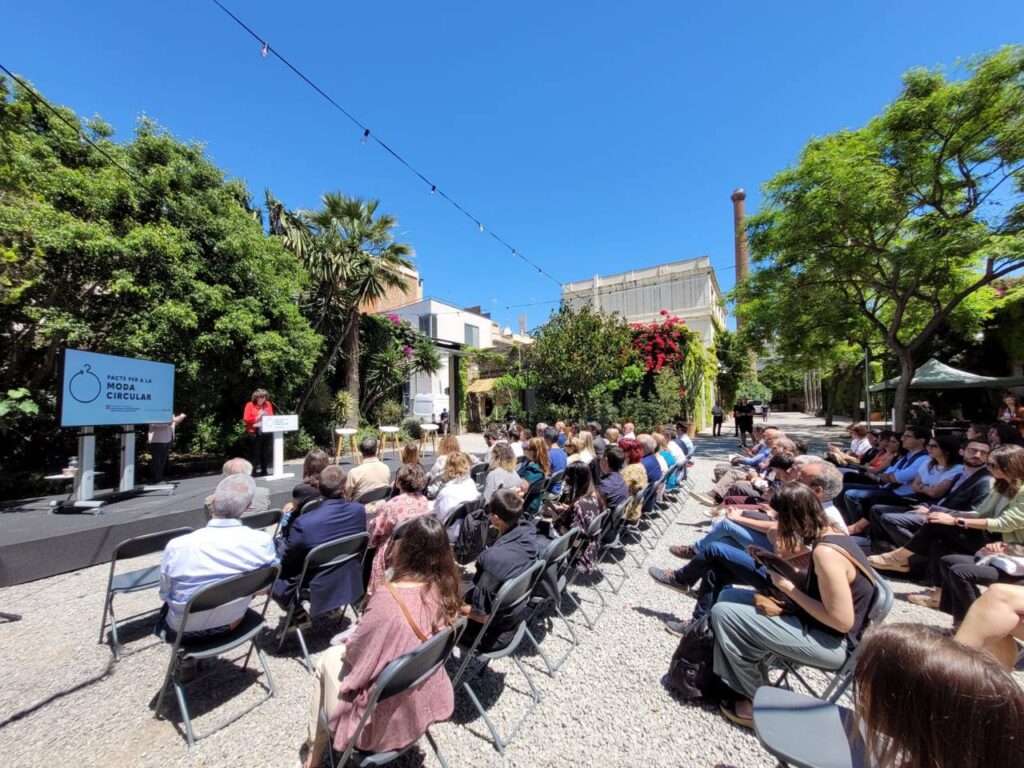The Maresme Waste Consortium is one of the driving forces behind the agreement
The signatory companies and organisations have undertaken to increase the selective collection of clothing from the current 12% to a minimum of 25% by 2024
The Maresme Waste Consortium is one of the driving forces behind the Circular Fashion Pact, an agreement to introduce advanced sustainability criteria in the textile sector, which was presented this Tuesday at the former Palo Alto factory site in Barcelona’s Poblenou district. Some fifty companies and organisations have already signed this voluntary pact to promote an urgent and necessary transformation of the textile sector, in a shared and collaborative way, establishing common objectives and generating instruments that make this change possible.
“For the Maresme region, this is a great opportunity to collaborate and establish synergies with the different agents in the textile value chain and the management of textile waste“, emphasised the director of the Maresme Waste Consortium, Carles Salesa.
The event was attended by the councillor for Climate Action, Teresa Jordà, the secretary for Climate Action, Anna Barnadas, the director of the Catalan Waste Agency, Isaac Peraire, and the director of the Consortium of Trade, Crafts and Fashion of Catalonia, Agnès Russiñol, as well as representatives of the signatory companies and organisations.
Jordà stressed the importance of the pact as “a decisive and courageous step towards a systemic transformation of the textile sector towards a circular model“.
The director of the Catalan Waste Agency, Isaac Peraire, assured that “the signatory organisations, companies and administrations are leaders of a necessarily immediate change“.
An open and transversal initiative
A group of 31 driving agents from the entire textile value chain, including the Maresme Waste Consortium, have been working together with the Government of Catalonia and other organisations to define the bases of the agreement, which was created with the aim of joining and coordinating the efforts of all the agents in the textile value chain to provide a joint and effective response to the challenges of the sector, establishing common objectives and generating instruments that make the transformation towards a circular model possible.
So far, 55 entities and companies have signed the pact, and it is still open to further backing. Among the signatories are manufacturing companies such as Mango, Pronovias and Míriam Ponsa, as well as the employers’ association Pimec, and textile managers such as Solidança, Roba Amiga and Humana.
This sectoral initiative is one of the circular economy pilot actions chosen by the European Union as part of the Interreg Europe CircE project due to its innovative nature and its potential for replicability in other territories.
Durable clothing and cleaner production
Given its global vocation, the pact sets objectives for each segment of the textile chain, which respond to the environmental, social and economic challenges of the sector.
In the area of manufacturing, for example, it seeks to increase the durability of products and the percentage of recycled material incorporated in fabrics, reduce and eliminate the use of harmful materials, increase reuse with the implementation of new business models and deploy cleaner and more efficient production strategies, among other scaling and innovation measures. To achieve these goals, work is already underway to define pilot projects in certain territories to promote the collection of second-hand clothing and its reuse, as well as to improve selective textile waste collection systems and the development of the local textile recycling industry.
The commitments made by the signatory organisations include reducing the generation of textile waste by between 5 and 10%; achieving between 25 and 30% in the selective collection of this fraction by 2024; and increasing the percentage of material recovery of the selectively collected part. Specifically, 55-60% should be destined for preparation for re-use and 40-50% for recycling of textile waste.
Anticipating the new law
The draft bill on the prevention and management of waste and the efficient use of resources in Catalonia, which will begin the process of public participation in July, includes specific objectives and measures for textile waste. By 2025, it proposes a nationwide reduction of 10% of this waste, with respect to that generated in 2019, and a 25% reduction by 2030. To this end, measures are proposed to encourage selective collection and reuse, such as the obligation to incorporate a second-hand textile shelf, or corner, in commercial areas larger than 1,200 square metres. The process of socialisation of the draft bill has begun with the aim that the final text will broadly incorporate contributions from organisations and the general public, and that the government will be able to approve it in 2023.
The textile sector is one of the largest consumers of resources in the world, with an enormous environmental and climate impact. Although 100 billion garments are sold every year, less than 1% of the waste generated by this product is recycled.
In Catalonia, each person consumes between 21.5 and 26 kg of clothing per year, but only 12% of textile waste is collected selectively, a total of 140,000 tonnes per year, which goes to landfill or is incinerated. Of the selectively collected part, half is prepared for reuse and 40% is recycled.
In fact, this waste has become a global problem. In the last 15 years, the number of items of clothing sold worldwide has doubled, while their lifetime has been reduced by about 20%. In contrast, reuse and recycling have not increased at the same rate, largely because textile products are often not designed for this purpose. Moreover, after food, housing and transport, global textile consumption is the fourth largest consumer of raw materials and water, and the fifth largest emitter of greenhouse gases (GHG).

A moment during the presentation of the Pact for Circular Fashion




